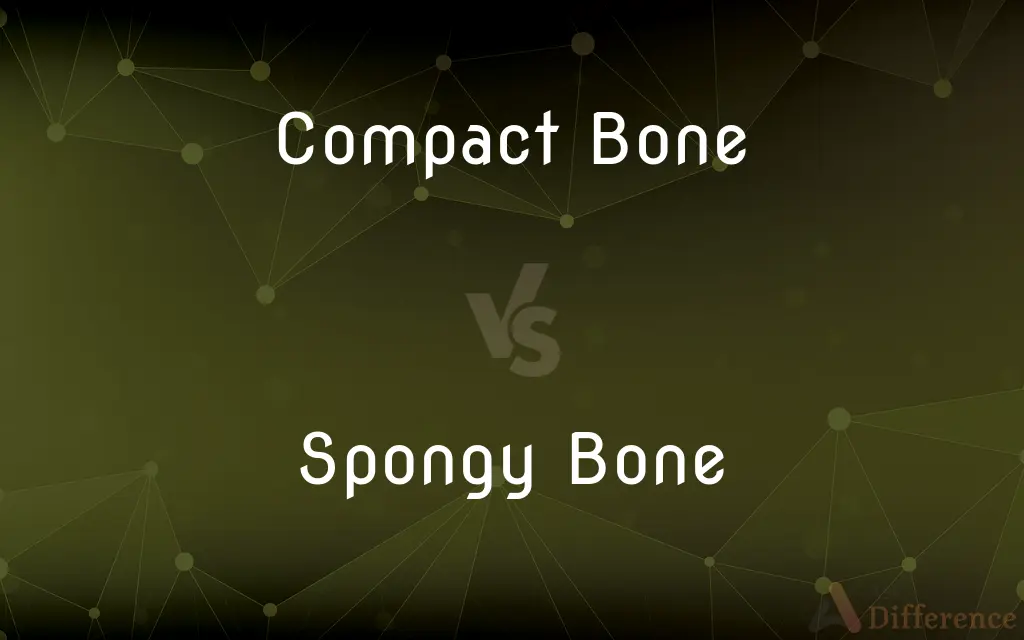Compact Bone vs. Spongy Bone — What's the Difference?
Edited by Tayyaba Rehman — By Fiza Rafique — Published on December 9, 2023
Compact bone is the dense, hard outer layer of bone, while spongy bone, found internally, has a porous structure resembling a sponge.

Difference Between Compact Bone and Spongy Bone
Table of Contents
ADVERTISEMENT
Key Differences
Compact bone and spongy bone are the two main types of osseous tissue found in the human skeleton. Compact bone is the hard and rigid layer that makes up the exterior of bones. It provides the primary structural support, ensuring bones can bear weight and resist bending. In contrast, spongy bone is lighter and less dense, characterized by a mesh-like structure that provides internal support and houses the bone marrow.
The architecture of compact bone is intricate, organized into concentric layers known as osteons. Each osteon is made up of concentric rings called lamellae, which encircle a central canal housing blood vessels and nerves. This structure ensures nutrients can be delivered to bone cells. Spongy bone, however, doesn’t have the osteon structure. Instead, it's made up of trabeculae, which are thin columns and plates of bone tissue. These trabeculae create cavities that contain the bone marrow, a critical site for blood cell production.
Functionally, compact bone and spongy bone play distinct roles in the body. Compact bone, with its dense composition, is pivotal for protecting internal organs and supporting body weight. Spongy bone, due to its porous nature, is vital for metabolic activities, as it facilitates the exchange of calcium ions and houses bone marrow where red and white blood cells are produced.
In terms of location, compact bone predominantly forms the outer layer of all bones in the body. It's the thick layer you'd see if you looked at a cross-section of, for example, a thigh bone. Spongy bone, on the other hand, is primarily found at the ends of long bones, within the vertebrae, and inside flat bones like the sternum. Its position facilitates its role in metabolic functions and blood cell production.
Comparison Chart
Structure
Dense with concentric osteons
Porous with trabeculae
ADVERTISEMENT
Function
Provides structural support and protection
Facilitates metabolic activities, houses bone marrow
Location
Outer layer of bones
Ends of long bones, vertebrae, and inside flat bones
Density
High
Lower due to porosity
Appearance
Solid and hard
Mesh-like and resembles a sponge
Compare with Definitions
Compact Bone
The dense, rigid exterior layer of bone tissue.
The femur's strength is due to its thick layer of compact bone.
Spongy Bone
Located internally, supporting and protecting bone marrow.
The vertebrae's spongy bone protects the vital bone marrow within.
Compact Bone
Bone tissue organized into concentric layers known as osteons.
Under a microscope, the concentric rings of compact bone reveal its structured nature.
Spongy Bone
Bone tissue characterized by a porous, mesh-like structure.
The ends of the humerus contain spongy bone, aiding in its lighter weight.
Compact Bone
The primary structural component of the skeleton.
Compact bone ensures our skeleton can bear our body weight efficiently.
Spongy Bone
Less dense bone tissue facilitating metabolic functions.
Calcium exchange often occurs within the spongy bone regions.
Compact Bone
Hard tissue that resists bending and provides protection.
The skull's compact bone protects the brain from external trauma.
Spongy Bone
Bone tissue that resembles a sponge due to its cavities and trabeculae.
A cross-section of the sternum reveals the characteristic appearance of spongy bone.
Compact Bone
Bone type with minimal cavities, offering dense support.
The rigidity of compact bone is vital for the skeleton's biomechanical functions.
Spongy Bone
Bone type with trabeculae that house bone marrow.
Spongy bone in the hip bone is a critical site for red blood cell production.
Common Curiosities
What cells are found in compact bone?
Osteocytes, osteoblasts, and osteoclasts.
What is spongy bone?
Spongy bone, also known as trabecular or cancellous bone, is the porous, lattice-like tissue found inside bones.
Where is spongy bone located?
It's found primarily at the ends of long bones, in the interior of vertebrae, and in the flat bones such as the pelvis.
Where is compact bone found?
It's primarily found on the outer surface of bones and makes up about 80% of the skeletal mass.
How does the structure of spongy bone differ from compact bone?
Instead of osteons, spongy bone has trabeculae, which are thin plates or beams of bone, creating an open structure.
What's the main function of spongy bone?
It supports and protects the red bone marrow, aids in producing blood cells, and helps absorb shock.
What is compact bone?
Compact bone, also known as cortical bone, is the dense, hard, and solid layer of bone that forms the outer shell of bones.
How is compact bone structured?
It's organized into repeating structural units called osteons or Haversian systems, which contain central canals and concentric lamellae.
Do both compact and spongy bone contribute to bone remodeling?
Yes, both types contain osteoblasts (build bone) and osteoclasts (break down bone), which play roles in bone remodeling.
What is the main function of compact bone?
It provides support, protection, and resistance against bending and torsion.
How do the mechanical properties differ between the two?
Compact bone is stiffer and bears weight, providing support. Spongy bone is more flexible, providing some resilience to bones.
Are both types of bone found in all bones?
Nearly all bones contain both types, but the proportion varies. For example, long bones have more compact bone in the shaft and spongy bone at the ends.
Are there blood vessels in spongy bone?
Yes, the spaces between trabeculae are filled with red bone marrow, which contains blood vessels.
How does nutrition impact these bones?
Proper nutrition, including calcium and vitamin D, is crucial for the health and maintenance of both compact and spongy bone.
Why is understanding the difference between the two important?
Recognizing the distinction helps in understanding bone physiology, disease processes, and guiding treatments for bone-related conditions.
Share Your Discovery

Previous Comparison
NPV vs. Payback
Next Comparison
Cost Centre vs. Profit CentreAuthor Spotlight
Written by
Fiza RafiqueFiza Rafique is a skilled content writer at AskDifference.com, where she meticulously refines and enhances written pieces. Drawing from her vast editorial expertise, Fiza ensures clarity, accuracy, and precision in every article. Passionate about language, she continually seeks to elevate the quality of content for readers worldwide.
Edited by
Tayyaba RehmanTayyaba Rehman is a distinguished writer, currently serving as a primary contributor to askdifference.com. As a researcher in semantics and etymology, Tayyaba's passion for the complexity of languages and their distinctions has found a perfect home on the platform. Tayyaba delves into the intricacies of language, distinguishing between commonly confused words and phrases, thereby providing clarity for readers worldwide.










































